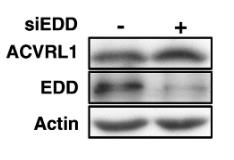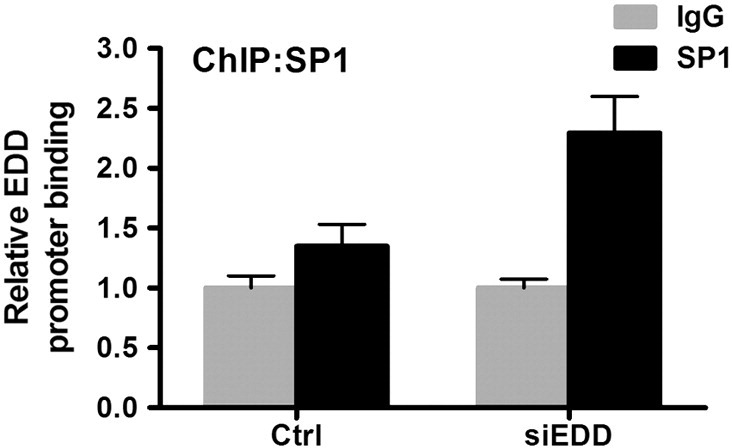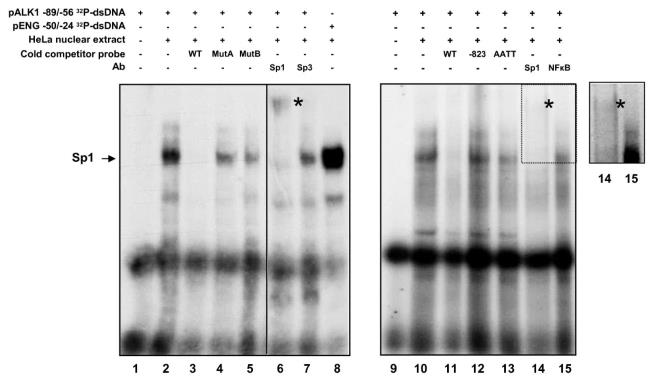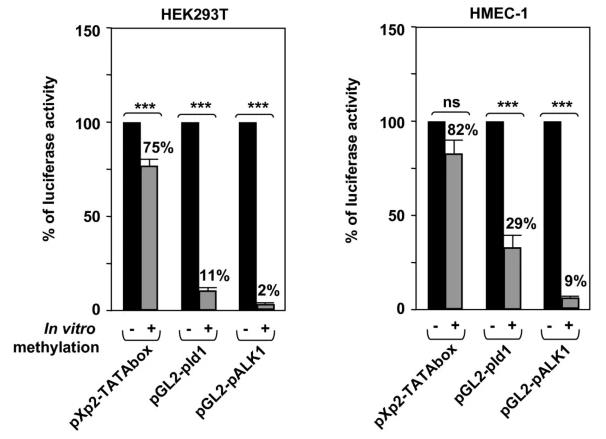Recombinant Human ACVRL1 protein, His-tagged
| Cat.No. : | ACVRL1-644H |
| Product Overview : | Recombinant Human ACVRL1 protein(P37023)(Asp22-Gln118), fused with C-terminal His tag, was expressed in HEK293. |
| Availability | April 02, 2025 |
| Unit | |
| Price | |
| Qty |
- Specification
- Gene Information
- Related Products
- Case Study
- Application
- Download
| Species : | Human |
| Source : | HEK293 |
| Tag : | His |
| Protein Length : | Asp22-Gln118 |
| Tag : | C-His |
| Form : | Lyophilized from 0.22μm filtered solution in PBS (pH 7.4). Normally 8% trehalose is added as protectant before lyophilization. |
| Bio-activity : | Immobilized Human GDF-2, No Tag at 2μg/ml (100μl/well) on the plate. Dose response curve for Human ALK-1, His Tag with the EC50 of 9.6ng/ml determined by ELISA. |
| Molecular Mass : | The protein has a predicted MW of 11.5 kDa. Due to glycosylation, the protein migrates to 25-30 kDa based on Tris-Bis PAGE result. |
| Endotoxin : | Less than 1EU per μg by the LAL method. |
| Purity : | > 95% as determined by Tris-Bis PAGE; > 95% as determined by HPLC |
| Storage : | Reconstituted protein stable at -80°C for 12 months, 4°C for 1 week. Use a manual defrost freezer and avoid repeated freeze-thaw cycles. |
| Reconstitution : | Centrifuge tubes before opening. Reconstituting to a concentration more than 100 μg/ml is recommended. Dissolve the lyophilized protein in distilled water. |
| Gene Name | ACVRL1 activin A receptor type II-like 1 [ Homo sapiens ] |
| Official Symbol | ACVRL1 |
| Synonyms | ACVRL1; activin A receptor type II-like 1; ACVRLK1, ORW2; serine/threonine-protein kinase receptor R3; ALK1; HHT; HHT2; activin receptor-like kinase 1; TGF-B superfamily receptor type I; activin A receptor, type II-like kinase 1; ORW2; SKR3; ALK-1; TSR-I; ACVRLK1; |
| Gene ID | 94 |
| mRNA Refseq | NM_000020 |
| Protein Refseq | NP_000011 |
| MIM | 601284 |
| UniProt ID | P37023 |
| ◆ Recombinant Proteins | ||
| Acvrl1-245R | Active Recombinant Rat Acvrl1 protein, His&hFc-tagged | +Inquiry |
| ACVRL1-768H | Active Recombinant Human ACVRL1 protein, hFc-tagged | +Inquiry |
| Acvrl1-2M | Recombinant Mouse Acvrl1 Protein, His (Fc)-Avi-tagged | +Inquiry |
| ACVRL1-276H | Recombinant Human ACVRL1 Protein, His (Fc)-Avi-tagged | +Inquiry |
| ACVRL1-090H | Recombinant Human ACVRL1 Protein, His-tagged | +Inquiry |
| ◆ Cell & Tissue Lysates | ||
| ACVRL1-994CCL | Recombinant Canine ACVRL1 cell lysate | +Inquiry |
| ACVRL1-3001RCL | Recombinant Rat ACVRL1 cell lysate | +Inquiry |
| ACVRL1-3093MCL | Recombinant Mouse ACVRL1 cell lysate | +Inquiry |
| ACVRL1-1191CCL | Recombinant Cynomolgus ACVRL1 cell lysate | +Inquiry |
| ACVRL1-2629HCL | Recombinant Human ACVRL1 cell lysate | +Inquiry |
Case 1: Chen HW, et al. Biochim Biophys Acta. 2013
EDD, first identified as a progestin-regulated gene in breast cancer, is a nuclear ubiquitin E3 ligase with roles in development and cancer. This study explored EDD's role in transcriptional regulation by identifying its direct target genes genome-wide. An integrated approach of gene expression and chromatin binding profiling pinpointed several targets, including ACVRL1, a TGF-β receptor important for blood vessel development.
The results showed EDD negatively regulates ACVRL1 expression at the promoter level. Loss of EDD resulted in upregulation of ACVRL1 and hyperactive Smad signaling, leading to disrupted vessel development and increased endothelial cell motility. This suggests EDD's critical involvement in vascular regulation and potential implications in angiogenesis-related diseases.

Fig1. Western blot analysis of ACVRL1 expression.

Fig2. EDD negatively regulates ACVRL1 promoter activity.
Case 2: Garrido-Martin EM, et al. BMC Mol Biol. 2010
In this study, researchers investigated the transcriptional origins and regulation of ACVRL1. Through in silico analysis of its 5'-proximal promoter sequence, they identified a high number of GC-rich Sp1 consensus sites, indicating a key role for Sp1 in ACVRL1 transcription. Using 5'RACE, they discovered two new transcriptional start sites upstream of the known one, leading to a previously unknown exon.
Deletion of Sp1 resulted in no significant transcriptional activity from the ACVRL1 promoter, while increasing Sp1 concentrations stimulated transcription in a dose-dependent manner. Silencing Sp1 in HEK293T cells dramatically reduced ACVRL1 transcriptional activity, and chromatin immunoprecipitation assays confirmed Sp1 binding sites across the promoter region in endothelial cells. DNA demethylation enhanced ACVRL1 transcription, whereas hypermethylation abolished Sp1-dependent transcriptional activation. These findings highlight the pivotal role of Sp1 and epigenetic regulation in controlling ACVRL1 gene expression.

Fig1. Electrophoretic Mobility Shift Assays (EMSA) shows the binding of Sp1 to the -89/-56 bp region of ACVRL1 promoter.

Fig2. Effect of in vitro methylation on the ACVRL1 promoter activity.
As a member of the transforming growth factor beta superfamily, ACVRL1 (ALK1) is a type I cell surface receptor whose mutation is associated with diseases such as hereditary hemorrhagic telangiectasia type 2 (HHT2) and fibrodysplasia ossificans progressiva (FOP), and therefore, the protein has applications in studying the cellular biological mechanisms of these diseases. The recombinant human ACVRL1 protein was validated for the Kinase Assay, which is an important experimental method for studying protein function and developing related drugs. Because ACVRL1 is associated with certain diseases, the recombinant ACVRL1 protein can be used to develop therapeutic drugs for these diseases, especially in drug screening and efficacy evaluation.
In the research of anti-angiogenesis drugs, ACVRL1 as a new target has received extensive attention. Targeting strategies for ACVRL1 are being explored to improve the symptoms of related diseases and provide new ideas and methods for treatment. This makes ACVRL1 not only an important object for basic biomedical research, but also a potential therapeutic target in clinical medical research.

Fig1. Targeting ALK1 signalling. (Amaya García de Vinuesa, 2016)
Not For Human Consumption!
Inquiry
- Reviews
- Q&As
Ask a Question for All ACVRL1 Products
Required fields are marked with *
My Review for All ACVRL1 Products
Required fields are marked with *
Inquiry Basket


